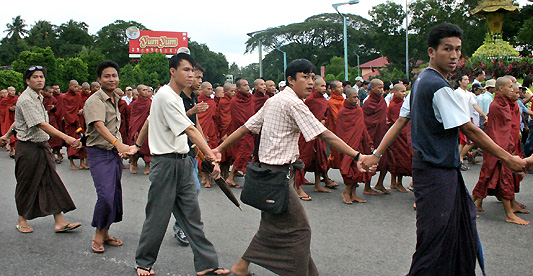Pressure builds on Myanmar generals
More than 50,000 join latest march as monks urge sympathisers to support protests.

|
“I think all the people of Myanmar must act to get democracy for a better life” aprat_1992, Denpasar, Indonesia |
An international aid agency official with employees monitoring the crowd estimated it was well over 50,000 and approaching 100,000.
Reports said other protests were taking place in other towns and cities including Mandalay, Masoeyein and Mya Taung led by monks holding alms bowls upside down in a symbol of protest.
On Saturday, the protests passed by the house of detained opposition leader Aung San Suu Kyi.
The Nobel Peace Prize winner appeared briefly at the gates of her home where she has spent much of the past 17 years under house arrest.
Witnesses said Aung San Suu Kyi, who has not been seen in public for more than four years, prayed with monks and wept as the protesters marched past.
On Sunday, however, heavy security was put in place around her home and another group of protesters was barred from approaching the area.
Monday will mark the seventh straight day of protests by the monks against Myanmar‘s military rulers.
| Myanmar’s monks |
|
|
The protests were originally sparked by the government’s sudden hike in the price of fuel last month, sending the price of transport and basic commodities soaring.
The initial protests began to falter after dozens of pro-democracy activists were arrested, but now the monks have taken up the vanguard of the movement, raising pressure on the government.
So far the demonstrations have remained peaceful, but witnesses say tensions have been growing.
On Monday, updates on the website of Irrawaddy magazine, run by exiled journalists based in Thailand, said doctors and medics were gathering at the Shwedagon pagoda amid fears of a confrontation.
Zinn Linn, an exiled journalist who spent several years in jail in Myanmar, told Al Jazeera the country’s military government is wary of inflaming tensions further.
“For many – even the most senior generals – to act against the monks is the highest crime in Buddhist teachings, so they are reluctant,” he said.
| Myanmar protests |
Other observers say Myanmar‘s ruling generals are concerned about how their actions will be perceived by major trading partners such as India and China.
“We think China has a lot to lose in all of this,” Nyo Myint, foreign affairs spokesman for Aung San Suu Kyi’s National League for Democracy, told Al Jazeera.
“China-Burma relations could reflect badly on Beijing ahead of next year’s Olympic games.”
China, which is eager to tap Myanmar‘s vast oil and gas reserves to fuel its booming economy, blocked a UN Security Council resolution earlier this year criticising Myanmar‘s rights record saying it was not the right forum.
However at the same time diplomats say Beijing has been quietly and subtly putting pressure on the military government, urging it to move towards democracy and speed up the process of reform.
 |
| Supporters have formed human chains to protect the monks’ marches [AFP] |
